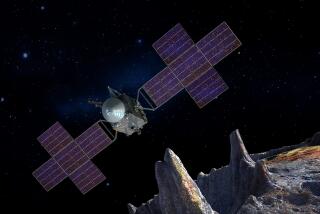NASA ready for GRAIL spacecraft to crash into moon
- Share via
In a series of planned maneuvers, NASA’s twin GRAIL spacecraft, nicknamed Ebb and Flow, will crash into a crater rim near the moon’s North Pole about 2:28 p.m. Pacific time on Monday.
At a news conference on Thursday, scientists involved with the project, which is operated out of the Jet Propulsion Laboratory in La Cañada-Flintridge, spoke about their work’s end.
“The mission is almost over, it’s kind of sad to me,” said David Lehman, GRAIL project manager.
On Friday morning, he said, engineers at JPL would fire the engines to point the twin crafts, which are about the size of the washer-dryers you’d find in an apartment, toward their mountain target. Following that maneuver, they will turn off the spacecrafts’ science instruments.
Over the weekend engineers will conduct a series of additional tests on the probes, and just under an hour before impact, they’ll burn the remaining fuel on each craft -- which could take anywhere from 0 to 9 minutes -- in an effort to measure how much fuel remains on board.
“It should help engineers improve mission designs in the future,” Lehman said.
Ebb and Flow will approach their final resting positions at a very shallow angle -- perhaps only slightly over one degree -- and should travel at about 3,760 miles per hour when they hit the moon’s surface. Ebb will impact first. Flow will follow about 20 seconds later, landing about 25 miles away. Both probes will be destroyed upon impact, the scientists said.
The Gravity Recovery and Interior Laboratory mission, as GRAIL is formally known, took advantage of interactions between Ebb and Flow to measure the lunar gravity field -- a first in planetary science beyond Earth’s orbit, as Los Angeles Times reporter Scott Gold recently wrote.
The three-month long, primary mission used the data to compile the “highest-resolution gravity field for any planet in the solar system, including Earth,” said principal investigator Maria Zuber of the Massachusetts Institute of Technology in Cambridge, Mass., at Thursday’s news conference. (While the moon is not popularly thought of as a “planet,” it is considered by scientists to be a planetary body.) Since August, GRAIL has been making further gravity measurements at lower altitudes. The data from that extended mission should become public by the end of May.
Having the high-resolution gravity map helps scientists learn more about lunar composition and, by extension, the makeup and history of other rocky planets and planetary bodies in the solar system, the researchers said. To cite just one example, Zuber noted that the team had learned that the lunar crust is far thinner than scientists had believed, which means the lunar mantle (the layer below the crust) has possibly been exposed by crater impacts. Studying exposed lunar mantle should help planetary scientists understand the Earth’s mantle, she said.
Further information about GRAIL findings is available at the mission website, which is maintained by NASA.







